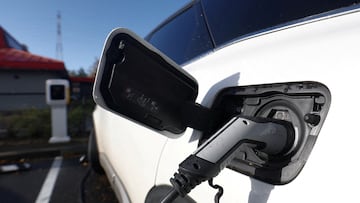Eligibility requirements to receive up to $7,500 for purchasing a vehicle with the EV Tax Credit
The federal government offers a tax credit to drivers looking to get a more environmentally friendly vehicle this year. Find out how to qualify.

The US Congress passed a bipartisan bill in 2022 to boost manufacturing production in the United States and develop clean energy. One of the features of the Inflation Reduction Act was to increase domestic production of green technology and get Americans to invest in it.
The Biden administration’s Investing in America agenda intends to solve the classic “which comes first” problem by augmenting government investment in both charging infrastructure and encouraging Americans to buy electric vehicles. In addition to dedicating $7.5 billion to building a national network of EV charging stations, the federal government is offering up to $7,500 in tax credits to those that buy a new EV car.
Eligibility requirements of the EV Tax Credit
The new rules for the $7,500 IRS credit only apply to new vehicles purchased after 1 January, 2023 but if you bought a car the year before, your EV may qualify for the prior rules. One major change to the Internal Revenue Code Section 30D, which the credit falls under, is that the electric vehicle must have its final assembly be in North America, this also applies to vehicles bought after 16 August, 2023.
Furthermore, not everyone can qualify for the credit as there are income limits as seen below.
Modified adjusted gross income (AGI) must not exceed:
- $300,000 - married couples filing jointly
- $225,000 - heads of households
- $150,000 - all other individual filers
You can use your income from the year that you purchase the new vehicle or the prior year, whichever is lower. Above those levels you won’t qualify for the clean vehicle tax credit, but over 70 percent of Americans earn less than $150,000.
You can claim the credit through Form 8936 with your tax return. It is necessary to take into account that you must provide the Vehicle Identification Number (VIN) of your vehicle.
Nor do all vehicles qualify for the credit either with a maximum manufacturer’s suggested retail price (MSRP) of up to $80,000 for vans, sport utility vehicles and pickup trucks, and $55,000 for other vehicles. The MSRP is the suggested retail price the manufacturer sets including options, accessories and trim but excluding destination fees. However, it is not necessarily the price you pay.
Besides the final assembly in North America requirement there are others that the vehicle must meet to qualify for the full $7,500 credit.
Vehicle requirements to qualify for the $7,500 credit?
The Treasury Department issued further guidance on the clean vehicle tax credit in October which took effect in January 2024. Those that purchase a new EV can immediately claim the credit of up to $7,500 and their previously owned clean vehicle credit of up to $4,000 at the point of sale at a car dealer starting January 1, 2024.
There are two parts to the credit, critical minerals and battery components. Each requirement will be eligible for $3,750 tax credit. Vehicles that meet both are eligible for a total tax credit of $7,500.
For vehicles placed in service January 1 to April 17, 2023, the base credit is $2,500 and the vehicle must draw propulsion energy from an battery with no less than 7kWh capacity, which tacks an additional $417 to the credit. Each additional kWh over 5kWh adds an additional $417 to the credit up to the cap of $7,500. Here are some other requirements.
For a vehicle to be eligible, it must:
- Have an external charging source
- Have a battery capacity of at least 7 kilowatt hours
- Have a gross vehicle weight class of less than 14,000 pounds*
- Meet critical mineral and battery component requirements (as of April 18, 2023)
- Be manufactured by a qualified manufacturer
- Be made by a manufacturer that hasn't sold more than 200,000 EVs in the US
- The sale qualifies only if the vehicle is new
- At the time of sale, sellers must report the required information to you and the IRS (your name and tax identification number )
*You can find your vehicle's weight on the vehicle's window sticker.
Which vehicles are eligible for the $7,500 tax credit?
Car buyers can check if the vehicle they are looking at on the car lot meets the final assembly location requirement for the $7,500 clean vehicle tax credit by using the Vehicle Identification Number (VIN) Decoder on the Department of Energy’s webpage.
The IRS provides a list of dozens of qualified manufacturers and you can check which vehicles qualify on the government’s Fuel Economy website.
While the Inflation Reduction Act targets new vehicle sales going forward from its passage, “All-electric and plug-in hybrid vehicles purchased new from 2010 through 2022 may be eligible for a federal income tax credit of up to $7,500,” according to the Office of Energy Efficiency & Renewable Energy website.
Clean vehicle tax credit amount
Related stories

Get ahead, apply for a tax filing extension

Avoiding mistakes can save you time in receiving your return
The amount of the credit depends on when you placed the vehicle in service. This is the date when you took delivery of the EV, regardless of when you purchased it.
For vehicles placed in service 1 January to 17 April, 2023
- $2,500 base amount
- Plus $417 for a vehicle with at least 7 kilowatt hours of battery capacity
- Plus $417 for each kilowatt hour of battery capacity beyond 5 kilowatt hours
- Up to $7,500 total
- In general, the minimum credit will be $3,751 ($2,500 + 3 times $417), the credit amount for a vehicle with the minimum 7 kilowatt hours of battery capacity.
For vehicles placed in service 18 April, 2023 and after
Vehicles will have to meet all of the same criteria listed above, plus meet new critical mineral and battery component requirements for a credit up to:
- $3,750 if the vehicle meets the critical minerals requirement only
- $3,750 if the vehicle meets the battery components requirement only
- $7,500 if the vehicle meets both
- A vehicle that doesn't meet either requirement will not be eligible for a credit.
Follow all the latest news on AS USA.

Complete your personal details to comment